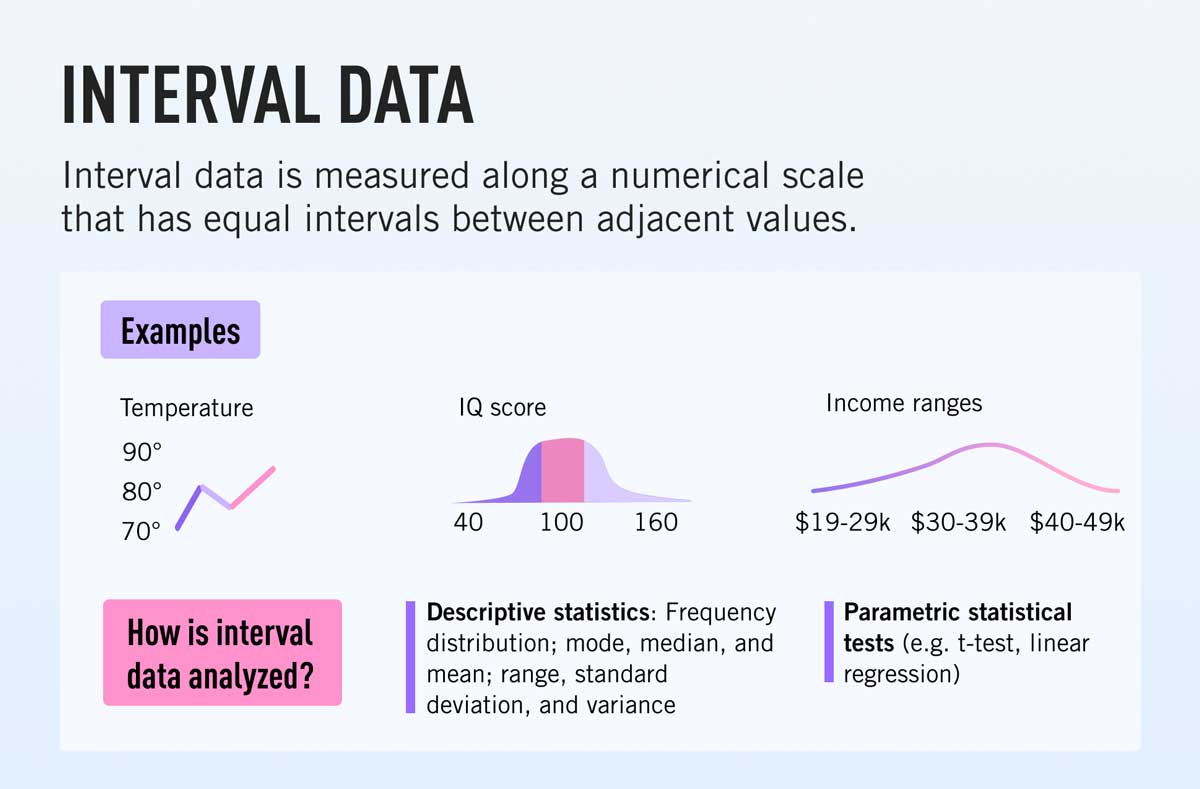If you’re like most people, you probably apply the interval data definition every day without even realizing it. For example, when you check the time on your clock, that’s interval data!
The interval data definition is simply a way of measuring something using equal intervals of time.
In other words, it’s a way of dividing up time so that we can better understand how things change over certain periods. There are many different ways to collect and analyze interval data.
In this guide, we’ll cover everything from how interval data is collected to how it’s analyzed.
Plus, we’ll discuss the benefits and limitations of using this type of data.
By the end, you should have a good understanding of what interval data is and how it can be used in various settings.
Table of Contents
- Interval Data Definition
- Interval Data Examples
- Interval Data vs. Ratio Data
- Ratio Data Examples
- How Is Interval Data Collected?
- How Is Interval Data Analyzed?
- What Are the Benefits of Using Interval Data?
- Frequently Asked Questions
- What is an example of an interval?
- What is the difference between interval and nominal data?
- Conclusion
Interval Data Definition
In the field of data management, there are a variety of ways to use interval data. Together with ratio data, interval data is the foundation of statistical analysis.
Interval and ratio scales are the highest forms of quantitative measurements. They allow for the most manipulation and transformation of statistical data.
There are four types of scale measurements: nominal, ordinal, interval, and ratio. The scale of your data tells you how you should interpret and manipulate the data points.
Let’s start with an interval data definition.
Interval data is classified and ordered by intervals, which specify that the distance between each value is equal. The distances are, therefore, important.
To put it in simpler terms, the difference between any two values on a scale is equivalent. That is why it is known as interval data. It is represented on a numerical scale and is a measure of both order and distance.
The Fahrenheit scale is the most common example of interval data measured on an interval scale. The difference between 100 degrees and 90 degrees is the same as the difference between 60 degrees and 70 degrees.
Weather forecasts are frequently based on temperature intervals. Interval data is utilized since temperatures are measured either in degrees Celsius or degrees Fahrenheit.
Time is another example of interval data measured on an interval scale because its value is constant, known, and measurable.
These characteristics make interval data ideal for several applications in the statistics and business intelligence fields.
However, there is one downside to interval data – the lack of a true zero.
In the interval scale, there is no “true” starting point. They do not start at 0 even though one value is labeled zero.
This means that zero does not signify an absence in our dataset. For instance, 0 degrees celsius is a temperature value.
Since there is no true zero, you can’t calculate ratios. The ratio of 90 to 30 degrees is not the same as 60 to 20 degrees. A temperature of 20 degrees does not mean it’s twice as hot as 10 degrees.
It is important to realize that we can only add and subtract intervals, not multiply or divide them. For instance, you can’t say 100 degrees is twice that of 50. That would be inaccurate.
The absence of a true zero in the intervals makes it impossible to compare how many times more valuable one thing is than another thing.
Interval scales only allow you to see direction and difference between numbers, but you cannot make any statements on their proportions or correlations.
In summary, here are the key characteristics of interval data:
- Interval scales show not only the order of your values and their direction but the precise differences between them as well.
- The distance between each number on the interval scale is identical.
- There is no absolute starting point.
- You can’t measure ratios.
- You can add and subtract values but you cannot multiply or divide.
Many statisticians can turn a non-interval scale into an interval scale to support data analysis.
Interval Data Examples
- Time of day in a 12-hour clock.
- Temperature in degrees Fahrenheit or Celsius (not Kelvin).
- IQ test.
- SAT and ACT scores.
- Age.
- Income range.
- Year.
- Voltage.
- Grade levels in school.
 (Source)
(Source)
Interval Data vs. Ratio Data
A key skill for data scientists is understanding the differences between interval data and ratio data.
Interval and ratio data are two types of high-level measurement. However, there are differences between the two that influence how you should analyze them.
Both interval scales and ratio scales show us the order and the exact value between the units. But, unlike interval scales, ratio Scales have absolute zero which allows you to do a wide range of statistical analyses.
Ratios have a clear definition at zero. Any measurable quantity can be represented with a ratio scale.
Height and weight are the most common ratio variables. For example, one child can be twice as tall or shorter than the other.
Scales that are based on ratio data are more flexible. You can add, subtract, multiply, and divide them.
So, with ratio data, you can do the same things as with interval data but you can also calculate your correlation and ratios.
Ratio Data Examples
- Weight.
- Height.
- The Kelvin scale (50 degrees Kelvin is twice as hot as 25 degrees Kelvin).
- Monthly income.
- Number of children.
- Number of elections a person has voted.
How Is Interval Data Collected?
Interval data is collected by measuring the attribute of interest at regular intervals. The interval can be of any length but is typically equal to the period over which the attribute is being measured.
How Is Interval Data Analyzed?
Interval data is analyzed by looking at the data points within a certain interval. This allows for comparisons to be made between different data sets, and for trends to be identified.
What Are the Benefits of Using Interval Data?
There are many benefits of using interval data, including the ability to more accurately compare and contrast different data sets, as well as the ability to more easily identify trends and patterns.
Additionally, interval data is less likely to be affected by outliers and is therefore considered to be more reliable.
Frequently Asked Questions
What is an example of an interval?
An example of interval data is the temperature on a Celsius scale.
What is the difference between interval and nominal data?
Interval data is data that is measured on a scale, where the differences between values are meaningful. Nominal data is data that is classified into categories, where the order of the categories is not important.
Conclusion
Based on the overall interval data definition, interval scales are very useful for understanding how things change over time. It can be used in a variety of settings, from analyzing the weather to measuring the success of a marketing campaign to tracking the growth of a child.
While there are some limitations to using interval data, its benefits far outweigh any drawbacks. So if you’re looking for a way to better understand changes over time, consider using interval data!





